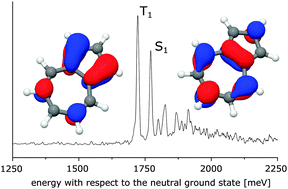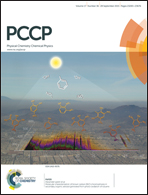Towards an understanding of the singlet–triplet splittings in conjugated hydrocarbons: azulene investigated by anion photoelectron spectroscopy and theoretical calculations
Abstract
In this work, the relative energetics and the character of singlet and triplet states of azulene have been investigated by photodetachment photoelectron spectroscopy (PD-PES) at radical anions and high-level multi-reference configuration interaction (MRCI) theory. Anion-to neutral electronic transition energies and singlet–triplet splittings have been measured directly by PD-PES and have been assigned with the help of the calculated transition energies and simulated Franck–Condon spectra. The good agreement between experiment and theory justifies the conclusion that the geometrical structure of the azulene radical anion lies in-between the geometries of the neutral ground state and those of the excited states. By the detour via the radical anion, we observed the T1 and S1 origins of azulene in the same spectrum for the first time and were able to resolve their small splitting of 49 meV. This small singlet–triplet splitting was explained before by the small overlap of the electron densities in the highest occupied and lowest unoccupied orbital. In this work, this concept is generalized and applied to the higher excited electronic states of azulene as well as to its alternant aromatic isomer naphthalene. The results confirm our hypothesis that the energetic splittings of corresponding singlet–triplet pairs can be related to the degree to which the electron density distributions of the involved half-occupied orbitals overlap.


 Please wait while we load your content...
Please wait while we load your content...